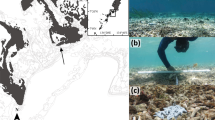Abstract
Diets of silver perch, Bidyanus bidyanus, in organically fertilised aquaculture ponds were dominated by chironomid larvae, Daphnia and calanoid copepods. Insects and crustaceans contributed approximately 80% and 20% by weight to the diet respectively. Classification of the stomach contents of individual fish revealed 8 diet groups, 4 of which were dominated by planktonic crustaceans and 4 by insects. Each diet group was strongly dominated by a different prey type. Fish from the same sample tended to belong to the same diet group and there was a non-random distribution of diet groups across ponds. Perch diets were influenced by the method of pond fertilisation (livestock effluent or pellet feed). Shifts in the representation of groups indicated that fish switched from one diet group to another over a 2–4 week period. The selection of planktonic prey by perch was related to prey densities in the ponds. Fish preferred Daphnia when these prey were common, but switched to calanoids and insects when Daphnia were scarce. A perfect rank correlation between the mean body size of planktonic prey and their contribution to the diet suggested that prey choice involved comparative decisions based on prey size. These findings indicate that, while classified as dietary generalists, silver perch exhibit consumption patterns which at the individual level are highly specialised at any given time. These patterns can be predicted, given information on prey densities in the environment.
Similar content being viewed by others
References cited
Barlow, C.C., R. McLoughlin & K. Bock. 1987. Complementary feeding habits of golden perch Macquaria ambigua (Richardson)( Percichthyidae) and silver perch Bidyanus bidyanus (Mitchell)(Teraponidae) in farm dams. Proc. Linn. Soc. N.S.W. 109(3): 143–152.
Bernays, E.A., K.L. Bright, N. Gonzalez & J. Angel. 1994. Dietary mixing in a generalist herbivore: tests of two hypotheses. Ecology 75: 1997–2006.
Bryan, J.E. & P.A. Larkin. 1972. Food specialization by individual trout. J. Fish. Res. Board Can. 29: 1615–1624.
Culver, D.A. & M.C. Geddes. 1993. Limnology of rearing ponds for Australian fish larvae: relationships among water quality, phytoplankton, zooplankton, and the growth of larval fish. Aust. J. Mar. Freshwat. Res. 44: 537–551.
Ehlinger, T.J. & D.S. Wilson. 1988. Complex foraging polymorphism in bluegill sunfish. Proc. Nat. Acad. Sci. USA 85: 1878–1882.
Holling, C.S. 1959. The components of predation as revealed by a study of small-mammal predation on the European sawfly. Can. Ent. 91: 293–320.
Hughes, R.N., M.J. Kaiser, P.A. Mackney & K. Warburton. 1992. Optimizing foraging behaviour through learning. J. Fish Biology 41 (Supplement B): 77–91.
Kieffer, J.D. & P.W. Colgan. 1991. Individual variation in learning by foraging pumpkinseed sunfish, Lepomis gibbosus: the influence of habitat. Anim. Behav. 41: 603–611.
Lavin, P.A. & J.D. McPhail. 1985. The evolution of freshwater diversity in the threespine stickleback (Gasterosteus aculeatus): site-specific differentiation of trophic morphology. Can. J. Zool. 63: 2632–2638.
Lechowicz, M.J. 1982. The sampling characteristics of electivity indices. Oecologia 52: 22–30.
Lobel, P.S. & J.C. Ogden. 1981. Foraging by the herbivorous parrotfish Sparisoma radians. Mar. Biol. 64: 173–183.
Magurran, A. E. 1992. Individual differences and alternative behaviours. pp. 441–477. In: T.J. Pitcher (ed.) Behaviour of Teleost Fishes, Chapman & Hall, London.
Malmquist, H.J., S.S. Snorrason, S. Skulason, B. Jonsson, O.T. Sandlund & P.M. Jonasson. 1992. Diet differentiation in polymorphic Arctic charr in Thingvallavatn, Iceland. J. Anim. Ecol. 61: 21–35.
Merrick, J.R. & G.E. Schmida. 1984. Australian freshwater fishes. Biology and management. Merrick, North Ryde. 409 pp.
Pierotti, R. & C. Annett. 1987. Reproductive consequences of dietary specialization and switching in an ecological generalist. pp. 417–442. In: A.C. Kamil, J.R. Krebs & H.R. Pulliam (ed.) Foraging Behavior, Plenum, New York.
Robinson, B.W., D.S. Wilson & G.O. Shea. 1996. Tradeoffs of ecological specialization: an intraspecific comparison of pumpkinseed sunfish phenotypes. Ecology 77: 170–178.
Rowland, S.J. & C.G. Barlow. 1990. Fish biology. The right prerequisites. Austasia Aquaculture 5: 27–30.
Rowland, S.J. & C. Bryant (ed.). 1995. Silver perch culture. Austasia Aquaculture for New South Wales Fisheries, Sandy Bay. 125 pp.
Skulason, S. & T.B. Smith. 1995. Resource polymorphism in vertebrates. Trends in Ecology & Evolution 10: 366–370.
Werner, E.E., G.G. Mittelbach & D.J. Hall. 1981. The role of foraging profitability and experience in habitat use by the bluegill sunfish. Ecology 62: 116–125.
Wu, L. & D.A. Culver. 1992. Ontogenetic diet shift in Lake Erie age-0 yellow perch: a size-related response to zoooplankton density. Can. J. Fish. Aquat Sci. 49: 1932–1937.
Author information
Authors and Affiliations
Rights and permissions
About this article
Cite this article
Warburton, K., Retif, S. & Hume, D. Generalists as sequential specialists: diets and prey switching in juvenile silver perch. Environmental Biology of Fishes 51, 445–454 (1998). https://doi.org/10.1023/A:1007489100809
Issue Date:
DOI: https://doi.org/10.1023/A:1007489100809




